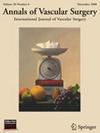A Systematic Review and Meta-Analysis on the Use of Omniflow for Peripheral Arterial Bypass
IF 1.6
4区 医学
Q3 PERIPHERAL VASCULAR DISEASE
引用次数: 0
Abstract
Background
Omniflow IIⓇ is a biosynthetic material specifically marketed for arterial bypass procedures at high risk of graft infection. This meta-analysis aimed to combine current evidence for the use of Omniflow IIⓇ in peripheral arterial bypass and compare postoperative outcomes.
Methods
Seven databases were searched for the term “Omniflow.” Studies were reviewed and included if: they were a randomized control trial, cohort study or case series; some patients in the study received Omniflow graft for peripheral arterial bypass. Primary outcomes were early and late postoperative infection; primary patency; and secondary patency. Number of patients, mode of bypass and postoperative outcomes were extracted from each eligible study. Meta-analysis of pooled results was undertaken using STATA.
Results
Literature search identified 30 studies. Following duplicate removal, abstract and full-text review, 12 studies were included, incorporating 1,100 bypass procedures. Follow-up ranged from 3-months to 5-years. Thirty-day postoperative infection data were available for 688 procedures with an average effect size of 0.25 (0.00, 2.12). Late postoperative infection data was available for 977 bypass procedures with an average effect of 1.68 (0.05, 4.67) after 30 days. Weighted pooled primary patency was 71.33% (95% confidence interval [CI] 62.83–79.18) at 1 year, 64.88% (95% CI 55.31–73.92) at 2 years, and 54.00% (95% CI 32.57–74.70) at 4–5 years. Weighted pooled secondary patency was 83.53% (95% CI 75.10–90.64) at 1 year, 76.75% (95% CI 57.84–91.59) at 2 years, and 73.10% (95% CI 60.16–84.35) at 4–5 years. Mortality data were reported for 1,068 procedures. Thirty-day mortality ranged from 0% to 7.69%, with an average mortality rate of 2.23%.
Conclusion
Omniflow IIⓇ presents a viable option for peripheral bypass graft material with low rates of early and late postoperative infection. Pooled primary and secondary patency rates for Omniflow IIⓇ appear comparable to other graft materials. Further comparative work is needed to directly compare Omniflow IIⓇ to alternative graft materials.
Omniflow用于外周动脉搭桥的系统回顾和荟萃分析。
目的:Omniflow II®是一种生物合成材料,专门用于高风险移植物感染的动脉旁路手术。本荟萃分析的目的是结合目前在外周动脉旁路治疗中使用Omniflow II®的证据,并比较术后结果。方法:在7个数据库中检索“Omniflow”一词。对以下研究进行回顾和纳入:随机对照试验、队列研究或病例系列;研究中一些患者接受了全流移植物外周动脉搭桥术。主要结局为术后早期和晚期感染;主要开放;还有次级通畅。从每个符合条件的研究中提取患者数量、搭桥方式和术后结果。使用STATA对合并结果进行荟萃分析。结果:文献检索确定了30项研究。经过重复删除、摘要和全文审查,纳入了12项研究,包括1100例旁路手术。随访时间为3个月至5年。688例手术术后30天感染数据,平均效应值为0.25(0.00,2.12)。977例旁路手术的术后晚期感染数据,30天后平均效果为1.68(0.05,4.67)。加权合并原发性通畅1年为71.33% (95%CI 62.83-79.18), 2年为64.88% (95%CI 55.31-73.92), 4-5年为54.00% (95%CI 32.57-74.70)。加权合并二次通畅1年为83.53% (95%CI 75.10-90.64), 2年为76.75% (95%CI 57.84-91.59), 4-5年为73.10% (95%CI 60.16-84.35)。报告了1068例手术的死亡率数据。30天死亡率为0%至7.69%,平均死亡率为2.23%。结论:Omniflow II®是外周搭桥材料的可行选择,其早期和后期术后感染发生率低。Omniflow II的一期和二期通畅率与其他移植材料相当。需要进一步的比较工作来直接比较Omniflow II®和其他移植材料。
本文章由计算机程序翻译,如有差异,请以英文原文为准。
求助全文
约1分钟内获得全文
求助全文
来源期刊
CiteScore
3.00
自引率
13.30%
发文量
603
审稿时长
50 days
期刊介绍:
Annals of Vascular Surgery, published eight times a year, invites original manuscripts reporting clinical and experimental work in vascular surgery for peer review. Articles may be submitted for the following sections of the journal:
Clinical Research (reports of clinical series, new drug or medical device trials)
Basic Science Research (new investigations, experimental work)
Case Reports (reports on a limited series of patients)
General Reviews (scholarly review of the existing literature on a relevant topic)
Developments in Endovascular and Endoscopic Surgery
Selected Techniques (technical maneuvers)
Historical Notes (interesting vignettes from the early days of vascular surgery)
Editorials/Correspondence

 求助内容:
求助内容: 应助结果提醒方式:
应助结果提醒方式:


